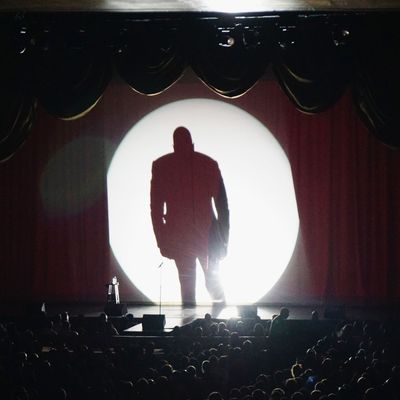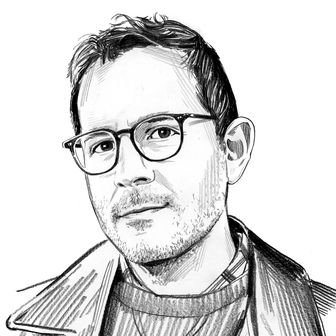
“When I’m onstage, I get real happy up there. Maybe that’s the only time in my adult life that I feel like myself. You’re standing up there — you know what I mean — like a gladiator, and them lights is on you, and you look down and everyone’s looking up at you … and it’s all these smiles around you. And they get dressed and they put perfume on and stuff, and they’re going to see your show. That feels good, man. These people, you know, they love you. Even if it’s for a minute, they really do. They love you, man. You know, it’s like a love-fest … It’s the best feeling, man. I love stand-up.” – Dave Chappelle, Inside the Actor’s Studio, 2006
The lights go dark. A giant silhouette of Dave Chappelle appears onstage. The curtain drops, and all you see is a puff of smoke. Wearing a slim black two-button suit, he tells the crowd, who collectively decided to giving him a standing ovation before he said a word, to sit down, to relax. “This is a very special night,” he says before launching into his first joke. “You know what I feel like, being in New York this week? Like a motherfucker who’s been locked up for a decade.” He pauses there, puffs his American Spirit, and lets the laughter settle a little. “People see me like, ‘Damn, nigga, you got swole. How have you been, baby boy?’ Pretty good! Pretty fucking good.” The crowd erupts in approval.
This is why he quit Chappelle’s Show. This is why he walked away from $50 million nine years ago. This is why he went to Africa. This is why he went silent, kept silent, and lived on a farm in Ohio. This is why he’d only reappear occasionally to perform poorly reviewed, loose, meandering sets of essentially shooting the shit. This is why, ten months ago, he stopped a performance in Hartford and just quietly read his book onstage. It wasn’t because he was crazy or on drugs or any of the myriad reasons people who aren’t Dave Chappelle liked to say. He quit so he could eventually come back and perform a show like the one he did last night, at Radio City Music Hall, in front of 6,000 deferential, diverse, well-dressed fans.
When I enter, I’m instantly and surprisingly overwhelmed with emotion. With a jazz trio called Supa Lowery Bros at the top of the stairs, playing an instrumental version of Kendrick Lamar’s oddly appropriate “Bitch Don’t Kill My Vibe,” I’m taken by how incredibly eclectic and buzzing the crowd is. I’m not exaggerating when I say it is the most diverse room I’ve ever been in. It looks like the streets of New York City were moved inside. It looks like the cast of Orange Is the New Black if it were half male and everyone were allowed to wear their cutest outfits (and not just because I eventually sat two seats down from Natasha Lyonne). A young Asian guy wearing a hat with the New Yorker logo on it stands in line in front of a white guy in a Twiztid hat, an Indian guy in a suit, an African-American skater in a Obey hat, and a woman in dreads who was talking to a woman with a feather in her hair. This is why Chappelle’s run of ten shows needed to be here, at Radio City. It’s big enough that I could see how wide-reaching his fan base is, but not so big (like Madison Square Garden would’ve been) that we turned into a faceless blob just moving in and out of passageways. With the band now playing a jazzed-up version of a Kanye West song, it is all reminiscent of Dave Chappelle’s Block Party, Chappelle’s 2006 concert documentary, which the comedian called the “best day of my career.”
The vibe continues inside Radio City’s massive auditorium, where a DJ spins a mix of neo-soul, old-school hip-hop, and random nostalgia hat-tips. Everyone knows every word of Biggie’s “Juicy” and the Cheers theme song. This is the first of the five shows Chappelle added after the first five sold out. Unlike on the previous nights, Chappelle splits the bill with a musician. In this case, Nas. Though Chappelle goes on first, don’t be fooled. It is his show.
Because he has a musician follow him, Chappelle’s one-hour-and-change set differs from the 90-minute ones that many publications reviewed last week. It’s a tight set. It is hour-special tight, which doesn’t come as too much of a surprise, considering all the signs in the lobby that said the entire night was being taped.
The show is comprised of four main chunks. He starts off with topical material, discussing the missing Malaysian plane (which he believes landed safely on “Tupac Island”), the Indian elections, Donald Sterling (pointing out that Sterling was so racist, he forgot Magic Johnson had AIDS), and Paula Deen (hilariously concluding with him hiring her and making her dress like Aunt Jemima), as if to say, “Don’t worry, I’ve been here the whole time.”
He then transitions to a section about race, asking, “Remember back in the ‘80s when only black people were mad?” In the past, Chappelle’s material on race was contentious and pointed (think of his classic bit about calling the police after someone broke into his home, only for them to assume he was the robber when they saw a black guy in a nice apartment); it’s now bordering on bemused. After years of being angry, he doesn’t have time anymore. He captures this with an example that felt like it could’ve been a Chappelle’s Show sketch: If he went into a KFC and all the employees were members of the KKK, he’d still order a two-piece. He laughs, “They’re the ones that have to work at KFC.”
Beyond Chappelle’s belief that African-Americans are no longer on the “racial hot seat,” it’s clear that part of his focus has shifted to the gay-rights movement. But, unlike he does with material about race, Chappelle approaches it as a supportive yet curious outsider, joking that he just wants to ask gay African-Americans how they prioritize their rage and what they’d do if a gay-pride parade and the Million Man March fell on the same day. It is the weakest, and the shortest, portion of the set. However, the lull doesn’t last long, as it leads into what is by far the strongest segment of his hour.
Chappelle started doing stand-up after reading a Time profile of Bill Cosby, and for the last 20 minutes or so of the set, it feels like he’s doing a tribute to his idol, telling longer-form stories about his current position as a family man. He tells a story about how every night before she goes to sleep, his wife tells him not to eat the kids’ lunches. It is such a Cosby premise, but then he makes it personal by adding, “You know how that goes: I might smoke some weed in the middle of the night, and she’ll leave neatly wrapped sandwiches all over the kitchen. Why wouldn’t I eat those sandwiches?” But he doesn’t even do that anymore, he says. Instead, he’ll just take small bites out of them. This is a tiny, pretty funny detail that doesn’t actually pay off for 15 minutes, when it is one of many callbacks in the set’s incredible last few minutes. This is a master at work. This is a comedian who has been doing stand-up for nearly three decades — three years longer than comedy wunderkind Bo Burnham has even been alive. This is Bobby Fischer (a figure Chappelle has often referenced, as Jason Zinoman points out in his fantastic Searching for Dave Chappelle) returning after years of isolation, when the hype has died down and he can just play chess.
He’s in control, I kept thinking to myself. The meaning is twofold. First, in terms of the fact that Chappelle is one of the greatest stand-up comedians ever. Sure, his punch lines are funny, but more than that, Chappelle is incredible at setups. He can create elaborate settings, like spinning a vivid description of going on a winter walk with his sister in full Muslim garb, and he can slow down his cadence and trick the audience into buying into a moment of sincerity. By combining the two, he’s able to say the absolute silliest things and have them kill. (The person behind me has a proclivity for saying “He’s so stupid” at all such punch lines. I love it.) The best example is during the LGBT chunk: Chappelle talks about a documentary showing a transgender person playing all these disgusting, hateful messages that he received on his answering machine. He goes on and on about how hard they are to listen to. But then, “It made me feel sad. It made me feel sad. Because, first of all, he still had an answering machine.”
It was more than the control of craft, however; it was control over how he’s perceived. It is what he’s been fighting for since he quit. Success brought Chappelle creative control in the sense that he and Chappelle’s Show co-creator Neal Brennan had complete freedom to write and shoot whatever they wanted. Success, however, by creating a bigger and different audience than they ever expected, left them unable to control what people were laughing at. This is what he meant when Time interviewed him in Africa and he kept on repeating, “I’ve got to check my intentions.” The example he brought up often after quitting came when shooting a sketch in which, in an attempt to skewer racism, Chappelle was performing in blackface. Chappelle says a white crew member laughed at the “wrong” part of the joke. As he explained on Oprah, it was the fundamental difference between an audience laughing with him and an audience laughing at him. This is a big difference for a comedian who famously will laugh at his own jokes.
Like many stand-ups and many other artists, Chappelle wants to be seen for who he really is, and comedy was his way of communicating that; but fame, which he always had difficulty with, obscured that to a point that made him feel it wasn’t worth it. Chappelle didn’t quit because he was crazy; he quit because he was sane, and he knew his audience was getting crazy. So, like a war of attrition, intentionally or not, Chappelle weeded the bad element out. After ten years, gone were the racists, the idiots, the bandwagon-jumpers, the people who shouted, “I’m Rick James, bitch” for no apparent reason. All the signs saying “NO heckling” weren’t necessary at Radio City. After a privately “pretty fucking good” and publicly tumultuous decade, the audience was most definitely ready to laugh with him.





